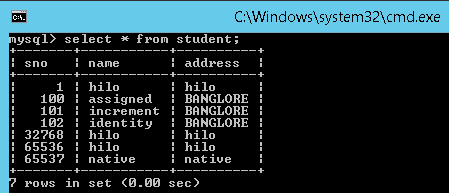Hibernate Generators
The <generator> subelement of <id> used to generate the unique
identifier for the objects of persistent class. There are many generator
classes defined in the Hibernate Framework.
Example:
<hibernate-mapping>
<class name="bo.EmployeeBo" table="employee">
<id name="eid" column="eid">
<generator class="assigned" />
</id>
<property name="name" column="name" />
<property name="address" column="address" />
</class>
</hibernate-mapping>
In Above example class="assigned" means, while inserting data into database
user will take care about generating Primary key value.
But, Hibernate can also generate the primary keys without user interaction, by using Generators.
List of generators
-
hibernate using different primary key generator algorithms, for each algorithm internally a class is created by hibernate for its implementation
-
hibernate provided different primary key generator classes and all these classes are implemented from org.hibernate.id.IdentifierGeneratar Interface
The following are the list of main generators we are using in the hibernate framework
-
assigned
-
increment
-
sequence
-
identity
-
hilo
-
native
-
foregin
-
uuid
1.assigned
-
This is the default generator class used by the hibernate, if we do not specify
<generator>element under<id>element then hibernate by default assumes it as -assigned” -
If generator class is assigned, then the programmer is responsible for assigning the primary key value to object which is going to save into the database
<class name="bo.EmployeeBo" table="employee">
<id name="eid" column="eid">
<generator class="assigned" />
</id>
<property>....</property>
</class>
2.increment
-
First select the max id if there, if no 1 as max
-
for each record it increments by 1 (i++)
-
Increment will take care by Application Layer[Hibernate]
<class name="bo.EmployeeBo" table="employee">
<id name="eid" column="eid">
<generator class="increment"/>
</id>
<property>....</property>
</class>
3.identity
-
First select the max id if there, if no 1 as max
-
for each record it increments by 1 (i++)
-
Increment will have taken care by DB Layer[MySQL]
-
MySQL, DB2 Support this. Oracle Won’t Support it.
<class name="bo.EmployeeBo" table="employee">
<id name="eid" column="eid">
<generator class=" identity"/>
</id>
<property>....</property>
</class>
4.sequence
-
while inserting a new record in a database, hibernate gets next value from the sequence under assigns that value for the new record
-
If programmer has created a sequence in the database, then that sequence name should be passed as the generator
-
Sequence start with 1 and Incremented by 1
-
Internally it creates Sequence table, and increment operations done here
-
Increment will take care by Both Application Layer[Hibernate] & DB Layer[MySQL]
-
MySQL, DB2 Support this. Oracle Wont
<class name="bo.EmployeeBo" table="employee">
<id name="eid" column="eid">
<generator class="sequence"/>
</id>
<property>....</property>
</class>
For defining your own sequence, use the param subelement of generator.
<class name="bo.EmployeeBo" table="employee">
<id name="eid" column="eid">
<param name="sequence">USER_DEFIED_SEQUENCE</param>
</id>
<property>....</property>
</class>
5.hilo
-
hilo start with 0
-
Internally it creates hilo table
-
It will take High value form Hilo table, and it will Increment
-
for each Deployment/Restart application, High value increment by 32768
-
1 st Deploy: 1,2,3,4…
-
2 nd Deploy: 32768,32769……….
-
MySQL, DB2 Support this. Oracle Won’t Support it.
<class name="bo.EmployeeBo" table="employee">
<id name="eid" column="eid">
<generator class="hilo"/>
</id>
<property>....</property>
</class>
6.native
when we use this generator class, it first checks whether the database supports identity or not, if not checks for sequence and if not, then hilo will be used finally the order will be.
-
identity
-
sequence
-
hilo
<class name="bo.EmployeeBo" table="employee">
<id name="eid" column="eid">
<generator class="native"/>
</id>
<property>....</property>
</class>
7.foregin
It uses the id of another associated object, mostly used with
8.uuid
It uses 128-bit UUID algorithm to generate the id. The returned id is of type String, unique within a network (because IP is used). The UUID is represented in hexadecimal digits, 32 in length.
Custom generator
For ur application, you want to generate keys as per ur wish like icici_101, icici_102, icici_103, ……….
-
write IciciGenerator class implementing IdentityGenerator
-
override generate method
-
and write logic for keys
<class name="bo.EmployeeBo" table="employee">
<id name="eid" column="eid">
<generator class="IciciGenerator"/>
</id>
<property>....</property>
</class>
Generators Example
EmployeeBo.java
package bo;
public class EmployeeBo {
private int eid;
private String name;
private String address;
//Setters & Getters
}
GeneratorsExample.java
package app;
import org.hibernate.*;
import org.hibernate.cfg.*;
import bo.EmployeeBo;
public class GeneratorsExample {
public static void main(String[] args) {
Configuration cfg = new Configuration();
cfg.configure("hibernate.cfg.xml");
SessionFactory factory = cfg.buildSessionFactory();
Session session = factory.openSession();
EmployeeBo bo = new EmployeeBo();
//bo.setEid(100);
bo.setName("sequence");
bo.setAddress("BANGLORE");
Transaction tx = session.beginTransaction();
session.save(bo);
tx.commit();
session.close();
factory.close();
}
}
EmployeeBo.hbm.xml
<hibernate-mapping>
<class name="bo.EmployeeBo" table="employee">
<id name="eid" column="eid">
<generator class="sequence" />
</id>
<property name="name" column="name" />
<property name="address" column="address" />
</class>
</hibernate-mapping>
Here we are changing generator classes one-by-one, check the how data stored in DB in output window.
hibernate.cfg.xml
<?xml version='1.0' encoding='utf-8'?>
<!DOCTYPE hibernate-configuration SYSTEM
"hibernate-configuration-3.0.dtd">
<hibernate-configuration>
<session-factory>
<property name="hibernate.connection.driver_class">com.mysql.jdbc.Driver</property>
<property name="hibernate.connection.url">jdbc:mysql://localhost:3306/smlcodes</property>
<property name="hibernate.connection.username">root</property>
<property name="hibernate.connection.password">root</property>
<property name="hibernate.dialect">org.hibernate.dialect.MySQLDialect</property>
<property name="show_sql">true</property>
<property name="hbm2ddl.auto">update</property>
<mapping resource="EmployeeBo.hbm.xml" />
<!-- <mapping resource="EmployeeBo.hbm.xml" /> -->
<!-- <mapping resource="Vehicle.hbm.xml" /> -->
</session-factory>
</hibernate-configuration>
Output

For Sequence,
Exception in thread "main" *org.hibernate.MappingException*: could not
instantiate id generator at
org.hibernate.id.IdentifierGeneratorFactory.create(*IdentifierGeneratorFactory.java:98*)